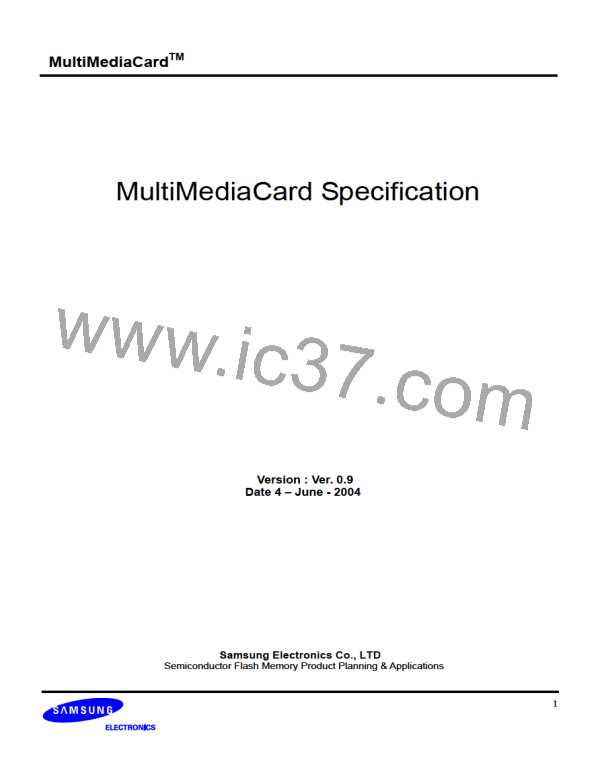MultiMediaCardTM
4.10 SPI Communication
The SPI mode consists of a secondary communication protocol. This mode is a subset of the
MultiMediaCard protocol, designed to communicate with a SPI channel, commonly found in Motorola’s
(and lately a few other vendors’) microcontrollers. The interface is selected during the first reset
command after power up (CMD0) and cannot be changed once the part is powered on. The SPI
standard defines the physical link only, and not the complete data transfer protocol. The
MultiMediaCard SPI implementation uses a subset of the MultiMediaCard protocol and command set.
It is intended to be used by systems which require a small number of card (typically one) and have
lower data transfer rates (compared to MultiMediaCard protocol based systems). From the application
point of view, the advantage of the SPI mode is the capability of using an off-the-shelf host, hence
reducing the design-in effort to minimum. The disadvantage is the loss of performance of the SPI
system versus MultiMediaCard (lower data transfer rate, fewer cards, hardware CS per card etc.).
While the MultiMediaCard channel is based on command and data bitstreams which are initiated by a
start bit and terminated by a stop bit, the SPI channel is byte oriented. Every command or data block is
built of 8-bit bytes and is byte aligned to the CS signal (i.e. the length is a multiple of 8 clock cycles).
Similar to the MultiMediaCard protocol, the SPI messages consist of command, response and data-
block tokens (refer to Chapter “Commands” and Chapter “Responses” for a detailed description). All
communication between host and cards is controlled by the host (master). The host starts every bus
transaction by asserting the CS signal low. The response behavior in the SPI mode differs from the
MultiMediaCard mode in the following three aspects:
- The selected card always responds to the command.
- An additional (8 bit) response structure is used
- When the card encounters a data retrieval problem, it will respond with an error response
(which replaces the expected data block) rather than by a time-out as in the MultiMediaCard mode.
Only single block read write operations are supported in SPI mode. In addition to the command
response, every data block sent to the card during write operations will be responded with a special
data response token. A data block may be as big as one card sector and as small as a single byte.
4.10.1 Mode Selection
The MultiMediaCard wakes up in the MultiMediaCard mode. It will enter SPI mode if the CS signal is
asserted (negative) during the reception of the reset command (CMD0). If the card recognizes that the
MultiMediaCard mode is required it will not respond to the command and remain in the MultiMediaCard
mode. If SPI mode is required the card will switch to SPI and respond with the SPI mode R1 response.
The only way to return to the MultiMediaCard mode is by entering the power cycle. In SPI mode the
MultiMediaCard protocol state machine is not observed. All the MultiMediaCard commands supported
in SPI mode are always available.
4.10.2 Bus Transfer Protection
Every MultiMediaCard token transferred on the bus is protected by CRC bits. In SPI mode, the
MultiMediaCard offers a non protected mode which enables systems built with reliable data links to
exclude the hardware or firmware required for implementing the CRC generation and verification
functions. In the non-protected mode the CRC bits of the command, response and data tokens are still
receiver. The SPI interface is initialized in the non protected mode. The host can turn this option on
and off using the CRC_ON_OFF command (CMD59).
4.10.3 Data Read Overview
49

 SAMSUNG [ SAMSUNG ]
SAMSUNG [ SAMSUNG ]